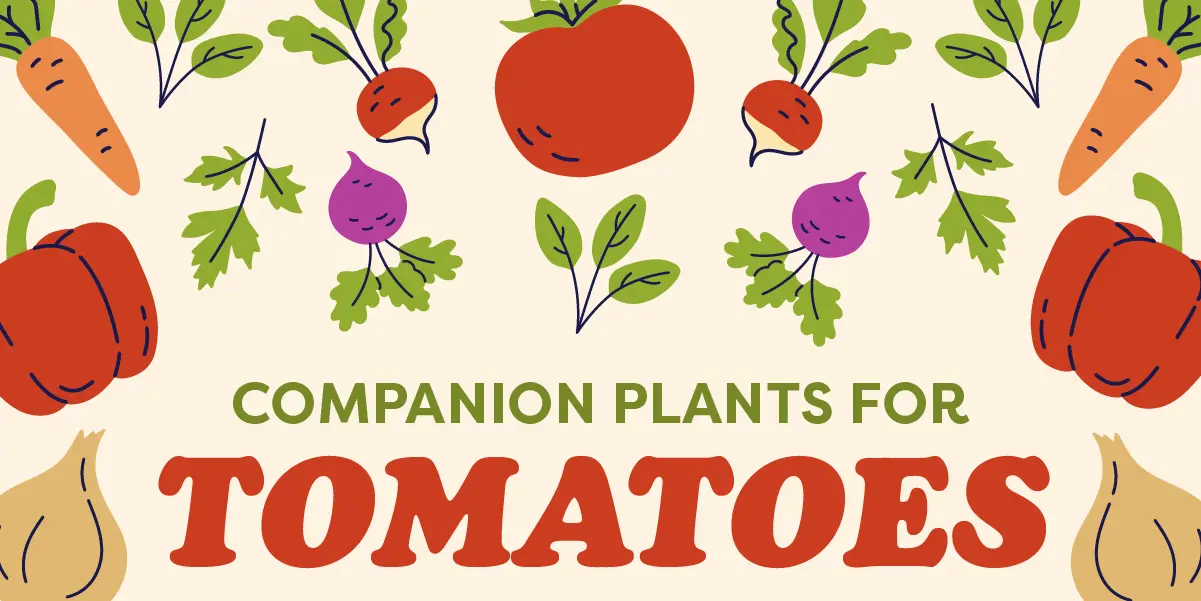Every garden contains a tomato plant or two, and many more if you’re willing to venture beyond the standard Beefsteak or Roma.
But did you know tomatoes fare much better with the right company? You see, plants need buddies, too!
They don’t get lonesome in the usual sense, lacking a central nervous system to process emotions, but they benefit heartily from companion planting, a technique unfamiliar to many first-time gardeners.
What Is Companion Planting?
Companion planting is the practice of growing different plants together for mutual benefit.
The right companions can boost productivity, improve soil health, and ward off pests.
This symbiotic relationship mimics nature, where plant diversity creates a balanced ecosystem. Companion planting is a natural choice that reduces reliance on chemical fertilizers and pesticides.
Benefits in a nutshell:
- Pest control by repelling or confusing harmful insects.
- Nutrient enhancement through nitrogen fixation or providing shade.
- Flavor improvement by affecting the biochemical processes of neighboring plants.
- Space optimization through efficient use of vertical or horizontal area.
- Attractive contrast that can beautify your garden and backyard landscape.
What Makes a Good Companion for Tomatoes?
Tomatoes are congenial plants that get along with others, but their ‘besties’ can take them to another level of productivity. Look for the following characteristics in companion plants:
- Complementary growth habits: Plants that grow in different ways can take advantage of vertical space or cast shade for each other.
- Pest-deterring properties: Some plants naturally repel pests or attract beneficial insects that prey on common tomato pests.
- Soil needs: Rotating crops is a common technique for reducing pests and maintaining soil health. Plants with different nutritional needs can balance the soil.
- Attractive blooms: Certain flowers attract pollinators essential for tomato production.
Best Companion Plants for Tomatoes
Finding the perfect plant partners for your tomatoes mixes science with a dash of tradition. Here’s your guide to the best companions for your tomato patch:
1. Borage
Borage is a pretty face and a powerhouse plant. Start today if you’re not already growing this mighty herb with edible leaves and flowers!
- Borage repels tomato hornworms, one of the most notorious tomato pests.
- It enhances pollination by attracting bees and other beneficial insects.
- It improves the health and flavor of tomatoes by fostering a thriving micro-ecosystem.
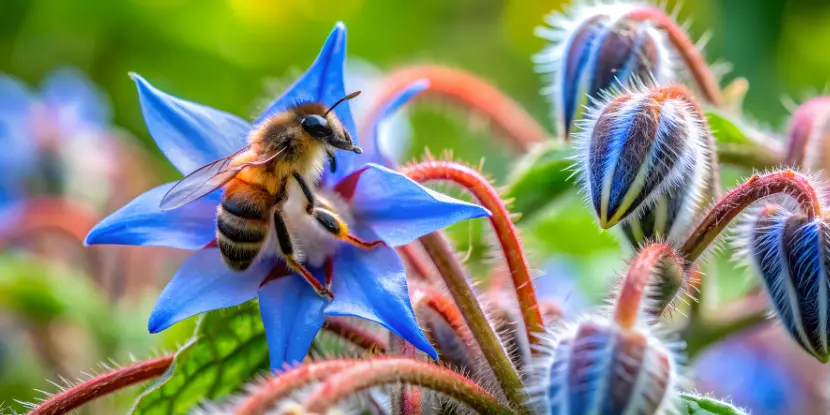
Borage attracts beneficial insects, and its flower makes a delicious cup of tea!
2. Chives
Chives spice up your culinary creations while safeguarding your tomatoes.
- Their pungent aroma deters aphids and spider mites.
- Chives’ long roots aerate the soil, providing better access to nutrients.
- These onion relatives bloom with attractive purple flowers that draw pollinators.
3. Marigolds
Marigolds are remarkably easy to grow, and their cheerful blooms and impressive benefits make them a must-have companion for tomatoes.
- They contain thiopene, a chemical that repels nematodes, tiny pests that attack roots.
- They attract hoverflies, beneficial insects that prey on aphids and other pests.
- Their bright colors invite pollinators.
- They deter rabbits, deer, and other critters that may graze on your crop.
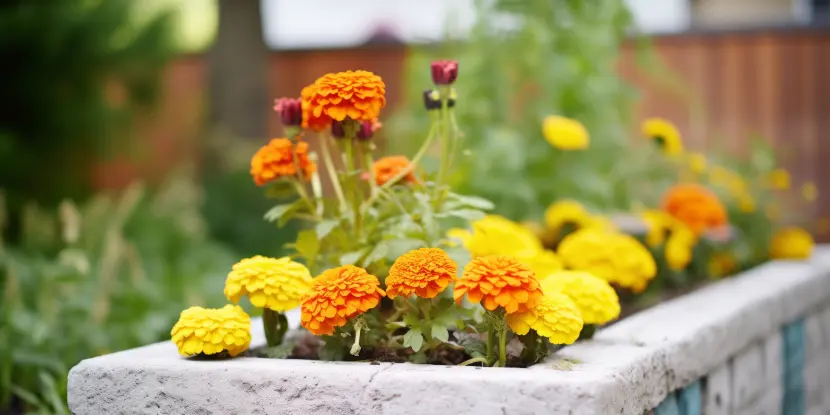
Marigolds contain thiopene, a chemical that repels nematodes, tiny pests that attack roots.
4. Basil
Basil and tomatoes are a culinary match made in heaven, and they’re fast companions in the garden, too.
- Basil can enhance the flavor of tomatoes when grown nearby.
- It repels pests like thrips, mosquitoes, and tomato hornworms.
- It’s a prime source of nectar for bees and other pollinators.
4. Nasturtiums
Nasturtiums are a bright and beautiful addition to a garden, with impressive benefits for tomatoes.
- Their pungent scent discourages aphids and whiteflies.
- They attract predatory insects like ladybugs that feed on tomato pests.
- Nasturtiums’ trailing growth habit makes them perfect ground cover for the base of tomato plants.
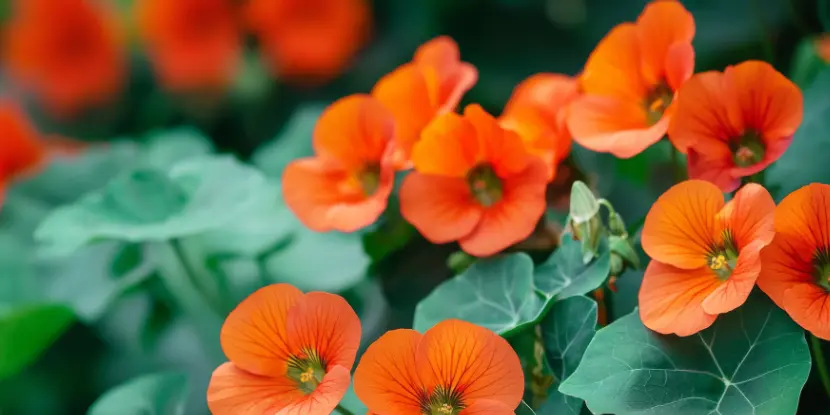
Nasturtium is an excellent ground cover plant, and its pungent scent discourages aphids and whiteflies.
5. Carrots
Carrots may not seem like an obvious companion for tomatoes, but these root vegetables make excellent garden neighbors.
- Carrots repel nematodes and other soil-dwelling pests.
- They provide shade for tomato roots, keeping them cool and moist in hot weather.
- The two plants’ different root depths prevent overcrowding and optimize soil use.
- Carrot roots break up the soil beneath tomatoes, improving aeration and drainage.
6. Garlic
Garlic is a garden staple, offering culinary and companion planting benefits.
- Its pungent smell confuses pests like aphids, spider mites, and whiteflies.
- It repels rabbits, deer, and other animals that may damage your tomatoes.
- Garlic can also improve the flavor of tomatoes when planted nearby.
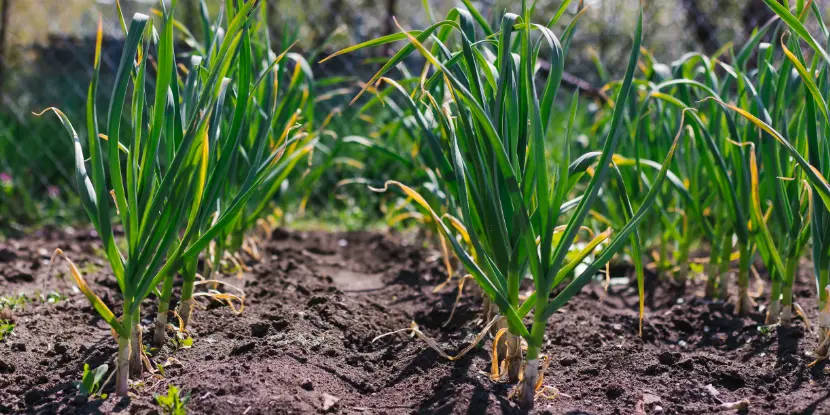
Garlic’s pungent smell confuses pests like aphids, spider mites, and whiteflies.
7. Parsley
Parsley is more than a garnish; it’s a versatile garden ally.
- It attracts beneficial insects like hoverflies, which prey on aphids.
- It can improve the growth and flavor of tomato plants.
- Rich in vitamins, parsley adds a nutritional bonus to your garden.
8. Peppers
Peppers are hot companions in more ways than one!
- Tomatoes provide shade for peppers, which prefer partial sun.
- Peppers repel tomato hornworms and other pests.
- The two plants’ different growth habits allow for efficient use of space.
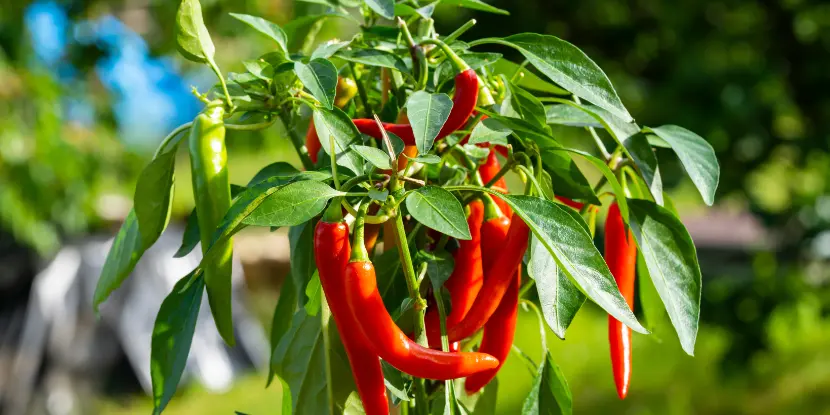
Peppers repel tomato hornworms and other pests.
9. Asparagus
Pairing asparagus with tomatoes works wonders for both plants.
- Tomatoes release solanine, which acts as a natural pesticide against asparagus beetles.
- In return, asparagus repels root-knot nematodes, benefitting tomato roots.
- This partnership promotes a healthy, pest-free garden environment.
10. Spinach
Tomato plants love spinach almost as much as Popeye does. It’s one of the best ground covers for tomatoes.
- It provides shade and conserves soil moisture during the hottest months.
- Spinach grows quickly and can be harvested multiple times.
- It can reduce weed growth and competition for nutrients.
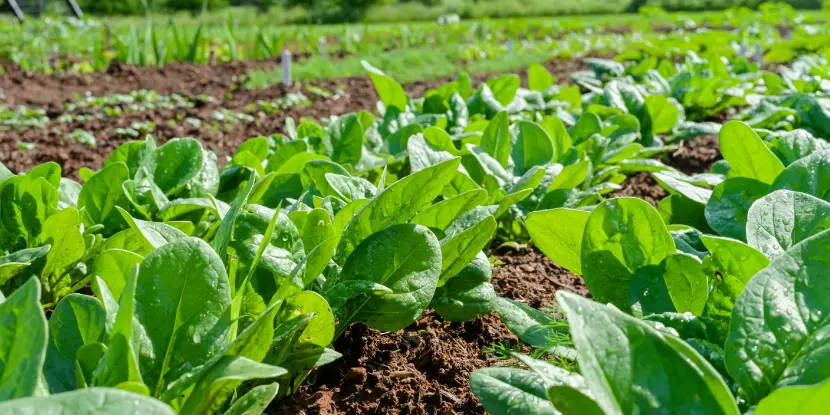
Planting spinach is the best way to attract Popeye to your garden.
11. Radishes
Radishes are quick growers and natural companions in salads, too.
- They repel flea beetles, which feed on tomato leaves.
- Radishes can act as a trap crop for pests like root-knot nematodes, reducing their population in the soil.
- They add nutrients to the soil as they decompose after harvest.
12. Beets
Beets provide a unique underground partnership with tomatoes.
- Beets help aerate the soil, improving health and nutrient access for tomatoes.
- They grow well under the shade of tomato leaves, making full use of garden space.
- This combination can lead to improved yields for both crops.
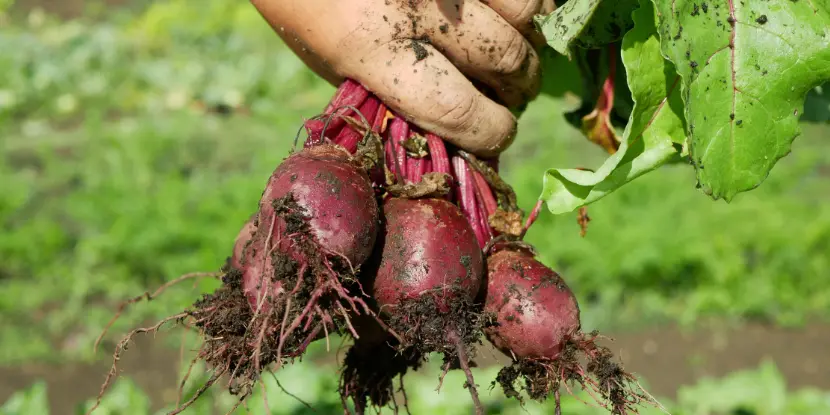
Beets aerate the soil for plants with shallower root systems.
Organizing Your Tomato Garden
Some other great companion plants for tomatoes include:
Thoughtfully arranging your tomato garden maximizes the benefits of companion planting.
Start with a layout accounting for sunlight, spacing, and each plant’s needs. Group plants with similar water and sunlight needs to simplify care.
- Create pathways to ensure easy access for maintenance and harvesting.
- Rotate crops annually to prevent soil depletion and pest build-up.
- Consider raised beds or containers if you’re limited on space to control soil conditions better.
Mixing companion plants can increase biodiversity in your garden and create a balanced ecosystem that naturally wards off pests and promotes growth. You’ll harvest bigger, juicier, and tastier tomatoes while beautifying your garden and offering a haven for bees, butterflies, and other beneficial insects.
FAQs: Companion Plants for Tomatoes
Q: Why is companion planting beneficial for tomatoes?
Companion planting helps tomatoes by deterring pests, enhancing flavor, and optimizing growth conditions. It creates a balanced ecosystem where plants support each other.
Q: How can I get the most out of my tomato companions?
Regularly tend your garden, monitor plant health, and adjust as needed. Rotate crops and replenish soil nutrients annually to maintain balance and productivity.
Q: Can companion plants improve the flavor of tomatoes?
Companion plants like basil and garlic enhance the flavor of tomatoes. Basil is particularly famous for its complementary taste when paired with tomatoes in culinary dishes, and its natural oils and fragrances can subtly influence the plant’s growth and flavor profile.
Q: What are the best companion plants for pest control?
Marigolds, garlic, and nasturtiums are excellent pest control plants. Marigolds contain thiophene, which repels nematodes, while garlic’s pungent scent confuses and repels many common pests, such as aphids and spider mites. Nasturtiums’ strong scent also deters aphids and whiteflies.
Q: How does the root structure of companion plants affect tomato growth?
Companion plants with different root depths, like carrots and beets, can benefit tomatoes by preventing overcrowding and optimizing soil use. They help improve soil aeration, drainage, and nutrient distribution, creating a healthier growing environment for tomato roots.
Q: Can companion planting help with water management in a tomato garden?
Certain companion plants, like spinach and carrots, offer shade for the soil, reducing evaporation. Planting these alongside tomatoes can help you manage water use.
Q: What role do beneficial insects play in companion planting?
Companion plants like marigolds and parsley attract beneficial insects like hoverflies and ladybugs. These insects control aphid populations and other pests.
Q: Should I consider companion planting in a small garden or container setup?
Companion planting is beneficial in any garden size, including small spaces or container gardens. It maximizes space, deters pests, and promotes healthy growth even in limited areas. Container gardening also allows for controlled soil conditions.

